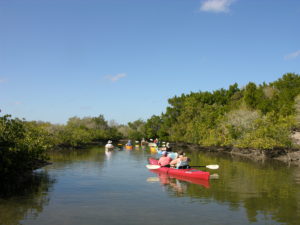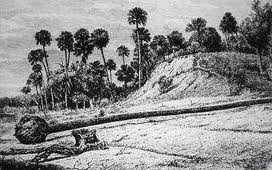 TOMOKA RIVER KAYAK (& CANOE) TOUR
TOMOKA RIVER KAYAK (& CANOE) TOUR
Group size: 1 – 24 people
Trip time: 3.5 hours
Skill level: Beginner – Expert
The meeting place is about 2 hours from Gainesville. This is a round-trip paddle, ending at the same spot from which we launch. We’re usually on the water for about 3.5 – 4 hours.
Trip description
On this trip we will be exploring the salt marshes on the lower part of the Tomoka river, near Ormond Beach on the east coast.
 This tributary of the Halifax River (actually a lagoon) is typical for and Atlantic coastal river in that it’s fairly short – only about 10 miles. The section we’ll be paddling on this days trip is the open salt marshes in the last few miles, where the river joins the Halifax.
This tributary of the Halifax River (actually a lagoon) is typical for and Atlantic coastal river in that it’s fairly short – only about 10 miles. The section we’ll be paddling on this days trip is the open salt marshes in the last few miles, where the river joins the Halifax.About 8 miles upstream from the area we will be paddling, the Tomoka river starts as a small, swampy backwater. From there, it experiences an impressive transformation. Leaving the swamp, it eases it’s way quietly through a densely shaded stand of cypress. After a couple of miles, it begins to open up. Passing under hwy 40, the river continues to widen while the ever increasing wash of sunlight spawns a change in the riverside vegetation. Thick groves of palm trees make a very interesting setting, forming thick mats of fallen fronds and leaf boots where reptiles and other interesting inhabitants live the good life.
By the time the stream enters the coastal lagoon known as Halifax River, it is a wide, tidal estuary dominated by saw grass marsh. Egrets, herons and cormorants are everywhere. Osprey are common too, as are bald eagles.
We can never imagine the battles, political intrigues, power struggles, spying, murder, love affairs, marriages, births, deaths and countless other events that transpired among the peoples of north Florida in the twelve thousand years following their arrival. We do, however, know the results – a powerful tribe known as the Timucua. But, within a few short centuries of the arrival of Europeans, this proud confederacy of tribes, that ruled all of Florida the from today’s Orlando, north to Georgia and west of the Suwannee River, were wiped out. Today, one of the few reminders that these people ever existed, is found in the name of this quiet river.
The local faction of Timucua were the Nocoroco. Their primary village was located on the northern end of the long peninsula that is now Tomoka State Park. Walking around this area, the thick base of oyster shells are all that remain of a once massive shell mound. Nearby (and closed to the public) is a fascinating prehistoric site known as the Tomoka Stone.
 The site gets its name from the presence of large coquina midden composed of fused masses of coquina shells, pottery shards (Orange fiber-tempered), sharks teeth and animal bones. Much of this site has been inundated by rising water levels and are now well preserved. Nearby, there are more coquina mounds, known as the Strickland Mound complex. The village of Nocoroco was visited and documented by the Spanish explorer Alvaro Mexia in 1605. It is thought that this might have been one of the last strongholds of the Timucua tribe. Perhaps this is why this humble little stream carries such an important name.
The site gets its name from the presence of large coquina midden composed of fused masses of coquina shells, pottery shards (Orange fiber-tempered), sharks teeth and animal bones. Much of this site has been inundated by rising water levels and are now well preserved. Nearby, there are more coquina mounds, known as the Strickland Mound complex. The village of Nocoroco was visited and documented by the Spanish explorer Alvaro Mexia in 1605. It is thought that this might have been one of the last strongholds of the Timucua tribe. Perhaps this is why this humble little stream carries such an important name.
